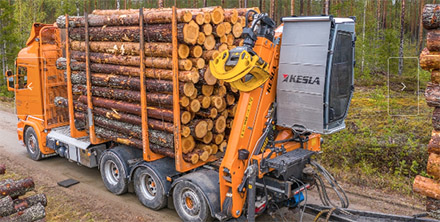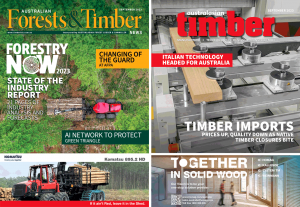Z-boom cranes have become more common in recent years. Finnish crane manufacturer Kesla estimates that Z-boom cranes already constitute almost 40% of its crane production. Source: Timberbiz
Alongside traditional Z-boom cranes, a front folded version has also been introduced to the market, which combines the benefits of straight-boom and Z-boom cranes.
The transport position of a Z-boom crane saves load space compared with straight-boom cranes, which leaves the full load space available for timber transport. The added benefits equates to several cubic metres. It is also easier to move the crane into the transport position when you do not need to make space in the timber load for the crane.
“If you neglect to make a gap in the load space for a straight-boom crane and place it on top, the combination may be too high to pass under some bridges. This is not a concern with Z-model cranes,” Business Director Ari Pirhonen of Kesla Oyj said.
The demand for Z-boom cranes has increased significantly in the past few years. While there is significant variation in the demand between countries, Kesla estimates that Z-boom cranes already constitute 40% of its production.
Kesla provides Z cranes from the 5-tonne-metre to the 24-tonne-metre class. They are primarily purchased for cut-to-length operations, but the largest 21 and 24 tonne-metre cranes are also suitable for handling long timber.
Z-boom cranes are usually installed at the rear of a truck with the exception of the largest models, which are usually mounted behind the cabin.
A few years ago, Kesla launched the front folded z cranes. They utilise the slew system of a straight-boom crane, but the crane itself is a Z-model. The crane’s pivot point is laterally in the middle of the vehicle, which means that the crane has equal reach on both sides. This model can also be transported with the boom extended in the load space.
Some customers also find that climbing into the cabin of a front folded crane is easier and safer.
In the transport position, the dimensions of a normal and front folded z crane are essentially the same but, due to the mounting position, the front folded crane needs to be slightly slanted when positioned for transport. The crane also takes slightly more space in the vehicle’s longitudinal direction than a traditional Z crane.
Z cranes have a significantly different geometry compared with straight-boom cranes. This may surprise some operators.
“Those considering the acquisition of a Z crane should absolutely try one out before buying, since it operates differently from a straight-boom crane,” Mr Pirhonen said.
Kesla’s crane range includes front folded z cranes with an integrated stabiliser legs in the 11–12 tonne-metre class and with a separate stabiliser legs in the 12–17 tonne-metre class.
“As has been the case with our other crane models, the most popular size class has risen to 12 tonne-metres in recent years,” Mr Pirhonen said.






